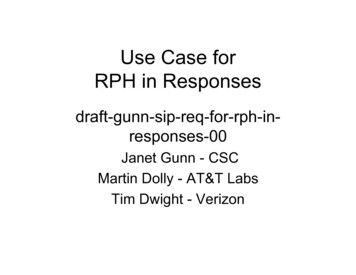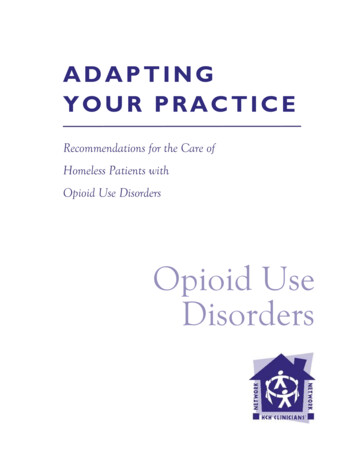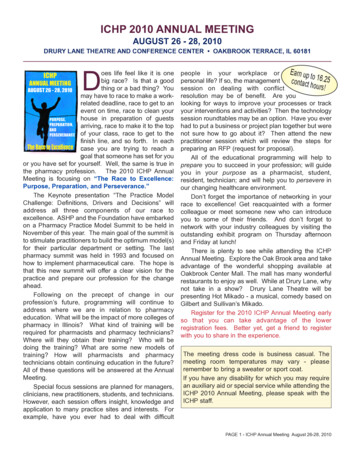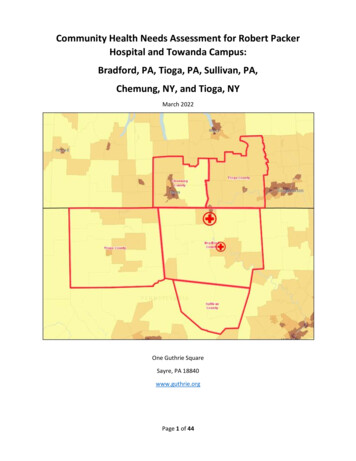
Transcription
Use Case forRPH in Janet Gunn - CSCMartin Dolly - AT&T LabsTim Dwight - Verizon
Background RFC4412 defines the Resource-Priority Header “RPH”,but is ambiguous about the use of RPH in responses As currently interpreted, any RPH header in a SIPresponse is ignored, but is not prohibited draft-polk-sip-rph-in-responses-00 “Allowing SIPResource Priority Header in SIP Responses" describes amodification to RFC4412 to permit RPH in responses Discussion on the SIP list indicated a need for moredetailed discussion of the Use Case motivating RPH-inresponses This Use Case focuses on elevated priority for access tomedia resources
Simplified GETS/WPS ParadigmEach authorized user is assigned a priority level- which is stored in adatabase– User may not know his/her priority level– UAC does not know the user’s priority level– User can not request a particular priority level User requests priority call and gets the assigned priority level This is NOT like MLPP– Priority level is only available AFTER authentication /authorization,which includes checking the data base. (wps.y) Priority is invoked on a “call by call” basis, by special “dialstrings”– Other invocation methods possible in the future Two tiered priority scheme– GETS “treatment” without known priority level (uses ets.0)– Priority within GETS treatment (uses wps.y)
Conceptual Network ViewIP or CircuitSwitchedAccessIP Core NetworkAGETSAuth.ServAccess is probablebottleneck undercongestion/crisis –focus of this Use CaseCore network is alsopotential bottleneck –but not the focus ofthis Use CaseBIP or CircuitSwitchedAccessAccess is probablebottleneck undercongestion/crisis focus of this Use Case
Conceptual Signaling Call FlowDetects “dialstring”,marks message,sends to GETS serverAuthenticates/authorizes call,retrieves user priority level from data base,Identifies final destinationASends GETS“dialstring”Sends marked message,with GETS “dialstring”GETSAuth.ServB
Conceptual Signaling Call FlowSends message to final destinationAGETSAuth.ServEither-UnauthorizedOr- User’s priority levelBSends marked message, withpriority level, and final destination
Conceptual Media Call FlowAGETSAuth.ServUser’s priority levelused in reservingcapacity for mediaUser’s priority levelused in reservingcapacity for mediaBUser’s priority levelused in reservingcapacity for media
SIP Call FlowDetects GETSindication in URI,sends to GETS serverAuthenticates/authorizes call,retrieves user priority level (3) from data base.(If not authorized, send 403)Identifies final destination and revises URIAINVITEURI indicates GETSSDP1INVITEURI indicates GETSRPH ets.0SDP 1GETSAuth.ServB
SIP Call FlowAGETSAuth.ServBINVITE withDestination URIRPH ets.0, wps.3SDP 1
SIP Call FlowAGETSAuth.Serv183 withSDP2 andRPH ets.0, wps.3B183 withSDP2 andRPH ets.0, wps.3
SIP Call FlowAGETSAuth.ServBReservation – using Priority 3Reservation – using Priority 3
Partial (Desired) Call Flowwith RPH in ResponsesAGETS ASB -----------(1) INVITE SDP1----- Look up in data base for priority level ( 3) ----(2) INVITE SDP1 RPH wps.3-- -(3) 183 SDP2 wps.3------------ -(4) 183 SDP2 wps.3 ----------- *** --*R*---(5) PRACK wps.3-------- *** *E* ---(6) PRACK RPH wps.3----*R*-- *S* *E* *E* -(7) 200 OK (PRACK)wps.3-*S*--- -*R*-(8) 200 OK (PRACK) wps.3-- *E* *V* *R* *A* *V* *T* *A* *I* *T* *O* *I* *N* *O* *** *N* *** *** *** ***
Security Concerns How does “A” know if the RPH in a response islegitimate?– After sending INVITE to GETS AS, “A” is expectingeither a 403 or a 183 with RPH Will ignore RPH in responses associated with other dialogs– “A” is expecting RPH in responses from specificsources, based on local policy, Will ignore RPH in responses from other sources, Will ignore RPH in responses if cannot trust identity ofsource, based on local policy (e.g., IPSec Tunnel)
Conclusion Objective- apply user’s priority toreservation process– With RPH in responses, it is straightforward toapply the user’s priority in reservations at bothends– Without RPH in responses, it is complicated toapply the user’s priority on the originating leg
draft-polk-sip-rph-in-responses-00 "Allowing SIP Resource Priority Header in SIP Responses" describes a . retrieves user priority level (3) from data base. (If not authorized, send 403) Identifies final destination and revises URI A INVITE B URI indicates GETS SDP1 INVITE URI indicates GETS RPH ets.0










